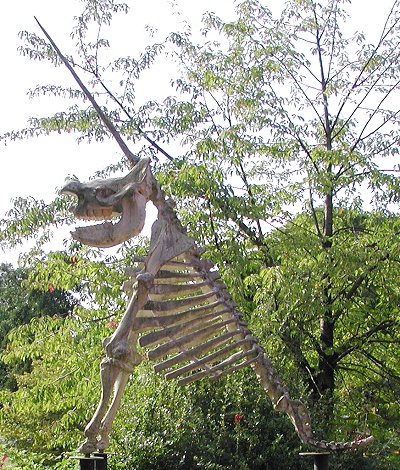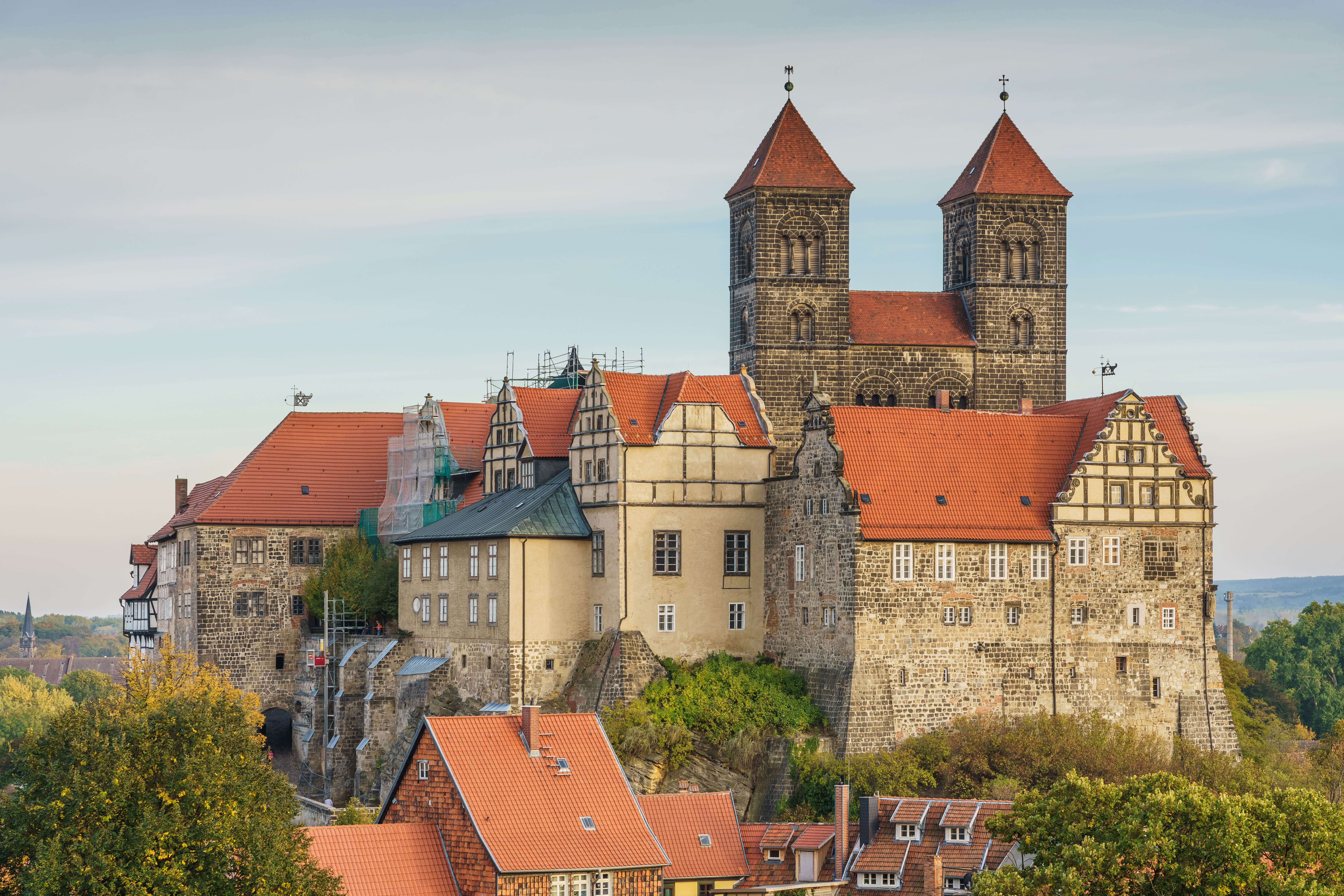|
Harz – Brunswick Land – Eastphalia National Geopark
The Harz – Brunswick Land – Eastphalia National Geopark () in central Germany extends from the Flechtingen Hills in the north to the gypsum karst region on the southern edge of the Harz and from east to west over the entire width of the mountain range on the territory of the three federal states of Lower Saxony, Thuringia and Saxony-Anhalt. It includes nature parks and other natural protected areas which are the reason why the Harz mountains, the Elm and the Drömling are destinations for tourists seeking to be close to nature. History The idea of establishing a national geopark emerged from the Eastphalian Open-air and Experience Museum in Königslutter. In 2002 the museum succeeded in engaging the Harz Regional Association and the GUf as partners. The Geopark has information centres in Königslutter, Quedlinburg and the Unicorn Cave. In 2015 it became a UNESCO Global Geopark UNESCO Global Geoparks (UGGp) are geoparks certified by the UNESCO Global Geoparks Council as ... [...More Info...] [...Related Items...] OR: [Wikipedia] [Google] [Baidu] |
Germany
Germany, officially the Federal Republic of Germany, is a country in Central Europe. It lies between the Baltic Sea and the North Sea to the north and the Alps to the south. Its sixteen States of Germany, constituent states have a total population of over 84 million in an area of , making it the most populous member state of the European Union. It borders Denmark to the north, Poland and the Czech Republic to the east, Austria and Switzerland to the south, and France, Luxembourg, Belgium, and the Netherlands to the west. The Capital of Germany, nation's capital and List of cities in Germany by population, most populous city is Berlin and its main financial centre is Frankfurt; the largest urban area is the Ruhr. Settlement in the territory of modern Germany began in the Lower Paleolithic, with various tribes inhabiting it from the Neolithic onward, chiefly the Celts. Various Germanic peoples, Germanic tribes have inhabited the northern parts of modern Germany since classical ... [...More Info...] [...Related Items...] OR: [Wikipedia] [Google] [Baidu] |
Eastphalian Open-air And Experience Museum .
{{Disambig ...
Eastphalian is: * a resident of Eastphalia (Ostfalen), a historic region of Germany; * the Eastphalian language (Ostfälisch) of West Low German Low Saxon (), also known as West Low German () are a group of Low German dialects spoken in parts of the Netherlands, northwestern Germany and southern Denmark (in North Schleswig by parts of the German-speaking minority). It is one of two di ... [...More Info...] [...Related Items...] OR: [Wikipedia] [Google] [Baidu] |
Nature Parks In Saxony-Anhalt
Nature is an inherent character or constitution, particularly of the ecosphere or the universe as a whole. In this general sense nature refers to the laws, elements and phenomena of the physical world, including life. Although humans are part of nature, human activity or humans as a whole are often described as at times at odds, or outright separate and even superior to nature. During the advent of modern scientific method in the last several centuries, nature became the passive reality, organized and moved by divine laws. With the Industrial Revolution, nature increasingly became seen as the part of reality deprived from intentional intervention: it was hence considered as sacred by some traditions (Rousseau, American transcendentalism) or a mere decorum for divine providence or human history (Hegel, Marx). However, a vitalist vision of nature, closer to the pre-Socratic one, got reborn at the same time, especially after Charles Darwin. Within the various uses of the word t ... [...More Info...] [...Related Items...] OR: [Wikipedia] [Google] [Baidu] |
Regions Of Lower Saxony
In geography, regions, otherwise referred to as areas, zones, lands or territories, are portions of the Earth's surface that are broadly divided by physical characteristics (physical geography), human impact characteristics (human geography), and the interaction of humanity and the environment ( environmental geography). Geographic regions and sub-regions are mostly described by their imprecisely defined, and sometimes transitory boundaries, except in human geography, where jurisdiction areas such as national borders are defined in law. More confined or well bounded portions are called ''locations'' or ''places''. Apart from the global continental regions, there are also hydrospheric and atmospheric regions that cover the oceans, and discrete climates above the land and water masses of the planet. The land and water global regions are divided into subregions geographically bounded by large geological features that influence large-scale ecologies, such as plains and features. As ... [...More Info...] [...Related Items...] OR: [Wikipedia] [Google] [Baidu] |
Nature Parks In Lower Saxony
Nature is an inherent character or constitution, particularly of the Ecosphere (planetary), ecosphere or the universe as a whole. In this general sense nature refers to the Scientific law, laws, elements and phenomenon, phenomena of the physical world, including life. Although humans are part of nature, human activity or humans as a whole are often described as at times at odds, or outright Anthropocentrism, separate and even superior to nature. During the advent of modern scientific method in the last several centuries, nature became the passive reality, organized and moved by divine laws. With the Industrial Revolution, nature increasingly became seen as the part of reality deprived from intentional intervention: it was hence considered as sacred by some traditions (Jean-Jacques Rousseau, Rousseau, American transcendentalism) or a mere decorum for divine providence or human history (Hegel, Marx). However, a vitalist vision of nature, closer to the pre-Socratic one, got reborn ... [...More Info...] [...Related Items...] OR: [Wikipedia] [Google] [Baidu] |
Geography Of Braunschweig
Geography (from Ancient Greek ; combining 'Earth' and 'write', literally 'Earth writing') is the study of the lands, features, inhabitants, and phenomena of Earth. Geography is an all-encompassing discipline that seeks an understanding of Earth and its human and natural complexities—not merely where objects are, but also how they have changed and come to be. While geography is specific to Earth, many concepts can be applied more broadly to other celestial bodies in the field of planetary science. Geography has been called "a bridge between natural science and social science disciplines." Origins of many of the concepts in geography can be traced to Greek Eratosthenes of Cyrene, who may have coined the term "geographia" (). The first recorded use of the word γεωγραφία was as the title of a book by Greek scholar Claudius Ptolemy (100 – 170 AD). This work created the so-called "Ptolemaic tradition" of geography, which included "Ptolemaic cartographic theory." ... [...More Info...] [...Related Items...] OR: [Wikipedia] [Google] [Baidu] |
UNESCO Global Geopark
UNESCO Global Geoparks (UGGp) are geoparks certified by the UNESCO Global Geoparks Council as meeting all the requirements for belonging to the Global Geoparks Network (GGN). The GGN is both a network of geoparks and the agency of the United Nations Educational, Scientific and Cultural Organization (UNESCO) that administers the network. The agency was founded in 2004 in partnership with the International Union of Geological Sciences (IUGS). The network was set up to conserve Earth's geological heritage, as well as to promote the sustainable research and development by the concerned communities. To implement these goals they adopted the concept of geopark, a term that had already been in use for one of the proposed parks. Geoparks were conceived as "single, unified geographical areas where sites and landscapes of international geological significance are managed with a holistic concept of protection, education and sustainable development." As the geopark did not naturally conform ... [...More Info...] [...Related Items...] OR: [Wikipedia] [Google] [Baidu] |
Unicorn Cave
The Unicorn Cave () is the largest show cave in the West Harz, about northwest of Scharzfeld in the borough of Herzberg am Harz in central Germany. It is a karst cave developed in dolomite strata that is part of the Zechstein. History The cave was first mentioned in the records in 1541. In 1686, Gottfried Wilhelm Leibniz visited the cave and wrote a report about it mentioning the local trade with unicorn artefacts. In those days, fossilized bones supposed to be from unicorns were ground and used for making medicine. In the 17th century, Otto von Guericke, the mayor of Magdeburg, wrote a newspaper article about the finding of some ancient animal bones in the Zeunickenberg, a Harz mountain near Quedlinburg. Based on Guericke’s writings, Leibniz drew a fictional reconstruction of the unicorn's skeleton using the bones that had been found in the cave and published the drawing in his book ''Protogaea''. In 1872, Rudolf Virchow carried out an excavation there and determined ... [...More Info...] [...Related Items...] OR: [Wikipedia] [Google] [Baidu] |
Quedlinburg
Quedlinburg () is a town situated just north of the Harz mountains, in the Harz (district), district of Harz in the west of Saxony-Anhalt, Germany. As an influential and prosperous trading centre during the early Middle Ages, Quedlinburg became a center of influence under the Ottonian dynasty in the 10th and 11th centuries. The castle, church and old town with around 2,100 Timber framing, timber houses, dating from this time of influence, were added to the UNESCO World Heritage Site, World Heritage List in 1994 because of their exceptional preservation and outstanding Romanesque architecture. Quedlinburg has a population of more than 24,000. The town was the capital of the Quedlinburg (district), district of Quedlinburg until 2007, when the district was dissolved. Several locations in the town are designated stops along a scenic holiday route, the Romanesque Road. History The town of Quedlinburg is known to have existed since at least the early 9th century, when there was a ... [...More Info...] [...Related Items...] OR: [Wikipedia] [Google] [Baidu] |
Harz Regional Association
The Harz (), also called the Harz Mountains, is a highland area in northern Germany. It has the highest elevations for that region, and its rugged terrain extends across parts of Lower Saxony, Saxony-Anhalt, and Thuringia. The name ''Harz'' derives from the Middle High German word ''Hardt'' or ''Hart'' (hill forest). The name ''Hercynia'' derives from a Celtic name and could refer to other mountain forests, but has also been applied to the geology of the Harz. The Brocken is the highest summit in the Harz with an elevation of above sea level. The Wurmberg () is the highest peak located entirely within the state of Lower Saxony. Geography Location and extent The Harz has a length of , stretching from the town of Seesen in the northwest to Eisleben in the east, and a width of . It occupies an area of , and is divided into the Upper Harz (''Oberharz'') in the northwest, which is up to 800 m high, apart from the 1,100 m high Brocken massif, and the Lower Harz (''Unterharz'') ... [...More Info...] [...Related Items...] OR: [Wikipedia] [Google] [Baidu] |





